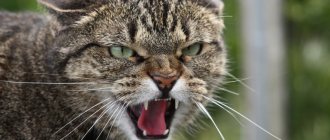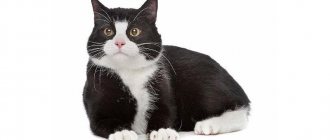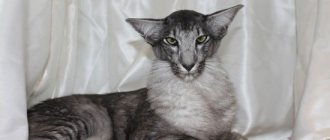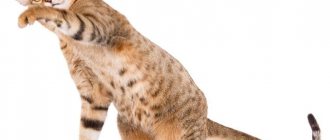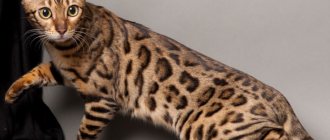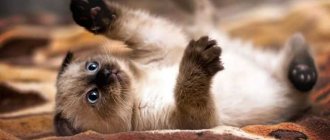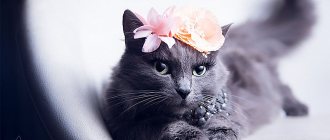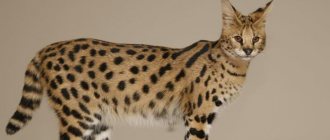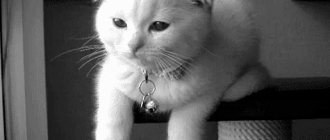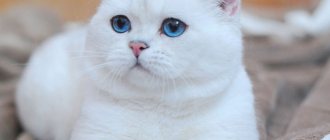Cats are not always affectionate and friendly with people or other animals. Cat owners know better about these features. The list of the most dangerous cats in the world would be made up of big cats, such as the lion, tiger, panther, but we will talk about those of them that man was able to tame or at least believes in it, because even small representatives of this family are capable of seriously mutilate a person. When choosing a kitten for your family, it is useful to know about the nature of its breed in order to be prepared for surprises.
The most dangerous cats in the world: characteristics
The love for exotic, rare pets, the desire to impress guests with an unusual animal living in the house has led to people getting cats that are completely unsuitable for apartment keeping.
The action leads to inconvenience. Wild animals spoil the design of housing, avoid people, get sick, experience chronic stress, and some representatives are quite dangerous for the owner and his family.
Mekong Bobtail
The Mekong Bobtail is the safest cat breed compared to all of the above. The height of a cat of this species reaches 30 centimeters at the withers, and it weighs no more than 4 kilograms.
If you train such a pet, it will be docile and calm. However, the Mekong Bobtail only gets used to one person. As a rule, he listens only to his master. The pet is wary of strangers. If he doesn't like something, he can easily attack a stranger.
The main danger of these 5 breeds is that they all come from wild cats. Consequently, raising such pets is extremely difficult. Only those who are willing to train and care for them should own such pets.
Savannah
Cats seem to have stepped out of ancient Egyptian frescoes: graceful flexible body, long legs and neck, small head, pointed ears.
The thick, short, spotted coat makes the cat look like a miniature version of a leopard. Savannahs tend to show a sharp character, wild habits, and aggressiveness. They may perceive strangers and other animals as objects of hunting. They can only be walked on a leash.
Exotic Shorthair
These cats are very similar to Persians: massive build, round head, small ears, huge round eyes and an incomparable, “sweet” expression on their face. The character of exotics is just as pleasant, calm and good-natured. What's the difference? Fur length. In exotics it is short, but no less thick. The standards allow almost all colors.
Exotics are so good that you can’t believe their origin is random. And this is exactly so. In the middle of the last century, US breeders improved the American Shorthair type by mating with Persians. The offspring were charming, but did not at all live up to the breeders' expectations. After a long discussion, it was decided to breed a new breed.
Abyssinians
The breed is suitable for people who are not ready to constantly communicate with their pet and do not expect excessive affection from it. The Abyssinian will take care of herself very well, prefers solitude, does not like to be cuddled, forced to play, and hides on closets and other high places in the apartment.
She has a developed intellect, is capable of learning to walk on a leash, fetch, and other commands, but tends to be quick-tempered.
Playing with her is fraught with scratches and bites. Having been punished, she is offended and vindictive. She is inquisitive, active, and if she picks up the key to her prickly character, she gets a devoted friend.
Manul
A wild cat does not live well in captivity. Kittens taken into the home, even with constant contact with people, remain wild, strive for solitude, and hide in secluded places.
An adult animal looks brutal, resembling a lynx. It reaches a height of 65 cm, weight up to 5 kg, but due to its thick, long, lush fur it gives the impression of being “robust”. Even in zoos, breeding Pallas' cats is rarely successful; most of the offspring die.
Long claws, sharp fangs, agility, and physical strength that help the Pallas' cat survive in the wild will cause a lot of trouble for the owner. The animal does not need the company of its relatives, does not like children or other pets living in the house. Can perceive a domestic cat or a small breed dog as game.
Be sure to read:
How to find out how many months a kitten is, learning to determine the correct age of the animal
You can read more about the Manul breed here
and here's another thing: Is it possible to train a Pallas's cat?
Siberian cats
Fluffy, handsome dogs with thick long hair, powerful paws, large muzzle and body. The weight of an adult cat is about 6 kg, and that of a male cat is 12 kg. The character corresponds to the name of the breed.
Loyal and devoted to their owner and his family, animals are full of inner dignity, do not tolerate familiarity from strangers, and will not allow themselves to be offended. They are friendly towards other animals and lenient towards children.
They are amenable to training, quickly adapt to the rules established for them, but in some moments they can be strictly principled. They need free space, personal territory, the opportunity to show natural instincts, and hunt.
Read more about Siberian cats.
Top 10 dangerous breeds
In addition to peaceful and friendly cat breeds, there are also those that are endowed with a willful and cocky disposition. Such pets are poorly adapted to living together with people and, under certain circumstances, become very aggressive and unsafe. When enraged, these cats can cause no less harm than a poisonous spider or an angry dog.
The list of the 10 most dangerous breeds includes:
- savannah;
- manul;
- Abyssinians;
- Siamese;
- Maine Coon;
- British;
- Siberian;
- Bengali;
- chausie;
- reed
Savannah
These large graceful animals are considered one of the most dangerous cats in the world. Although Savannahs can be tamed, there is always a risk that they will become aggressive.
The owners of these cats must always be on alert, because their graceful pets often perceive strangers as objects of hunting.
Manul
This wild feline is similar to a lynx and is completely untamed. Even a manul raised in captivity will avoid people. These aggressive and dangerous cats are not suitable for home keeping.
No matter how hard you try, it is impossible to teach wild Pallas’ cats commands and stop them from damaging their owner’s property.
Abyssinians
These sophisticated oriental beauties also belong to the category of dangerous cats. It turns out that representatives of the breed are very vindictive and immediately take revenge for insults inflicted on them. Without proper attention, Abyssinians become wild and aggressive.
Siamese
These cunning and dangerous cats are very aggressive and vindictive. They can harbor a grudge for a long time and take revenge at the most unexpected moment. Siamese cats do not like excessive attention and do not tolerate familiarity. It is not advisable to take representatives of the breed into families with children.
These cats pose a real danger to children who do not yet know how to properly handle a pet.
Maine Coon
These smart and flexible animals are endowed with a changeable disposition and can begin to take revenge even for a minor offense. Large and dangerous Maine Coon cats cannot stand loneliness and, due to their size, are capable of crippling a person.
British
This cute domestic cat is endowed with an independent and willful character. The proud and freedom-loving Briton has no love for strangers and prefers to distance himself from them. He can hardly tolerate being picked up or forced to play.
Siberian
This large and quite dangerous cat is wary of strangers and can only get along with someone who has a highly developed sense of self-esteem.
An independent and strong Siberian can be both affectionate and sensitive, and aggressive. To smooth out developed hunting instincts and avoid unwanted behavior, this cat must be trained from an early age.
Bengal
This impulsive and dangerous cat has highly developed hunting instincts. To prevent a Bengal kitten from becoming an aggressive monster, it is raised in a calm atmosphere.
An active and mobile animal does not like to be forcibly held in arms and does not tolerate being addressed in a raised voice. An angry Bengal cat can be unsafe and capable of causing serious damage.
Chausie
These powerful animals, more like a puma, also belong to the category of aggressive and unsafe breeds. Aggressive cats need to be dealt with constantly and dangerous games should not be played.
Chausies have developed hunting instincts, do not tolerate confined spaces and are not suitable for apartment living.
Reed
This aggressive and dangerous cat with the appearance of a lynx is practically impossible to domesticate and is difficult to train. She needs constant communication, and if there is a lack of it, she quickly runs wild.
Bengal cats
From early childhood, Bengal kittens need their owner's love, attention, and a warm atmosphere. Very mobile, active, they retain the desire to play and hunt until old age. They can climb curtains, damage furniture, without being able to splash out energy in a peaceful direction.
You can’t shout at them, much less hit them. Grievances are remembered for a long time. The character of the Bengal breed is explosive, impulsive, and prone to revenge. Breeders know many cases of a pet attacking its owner, affecting the cat's pride.
The Bengal breed should be raised patiently, using affection, kindness, taking into account the animal’s independence of character and love of freedom.
For those interested, you can look at the size and weight of the Bengal by month. and you will find a lot of new and useful things there.
Jungle cats
A large breed, the weight of an adult reaches 15 kg. Jungle cats are not completely domesticated, even when raised in a human family from a young age. They do not like to be touched or stroked; they prefer to spend time alone, minding their own business.
It rests during the day and is active at night. Keeping a predator in an apartment is a dubious undertaking; it will happily jump around, demolishing vases and decorative items along the way, use curtains to climb higher, and repeatedly sharpen its claws on furniture, leaving deep marks on the upholstery.
If you really want to have a pet with the appearance of a lynx, it is better to place it in a spacious enclosure.
Maine Coon
Of the domestic cats, the largest is the Maine Coon, which has a massive body and a wide chest. A non-obese Maine Coon can weigh up to 15 kg. They are often bred as exotic cats. But they may not be harmless, sometimes they can show aggression, and the large size of the cat can mean more serious injuries. If a stranger enters the territory of the house, the Maine Coon may meet him aggressively. But at the same time, breeders note their flexibility and high intelligence - Maine Coons can pick up on the intonations of their owners and respond to their requests. They are very curious and therefore require close attention to themselves. They don’t like to be left alone, so if a Maine Coon needs to be left alone for a while, then you should provide it with toys, otherwise the owners will later regret leaving it. Maine Coons do not require special conditions to keep; they feel good in any climate. But during walks you should not leave them alone, as their mood can instantly change.
Aggressive cat breeds: features, how to influence
Some domestic cats have a naturally explosive temperament; before choosing a specific breed, you need to familiarize yourself with its character and understand whether it matches the conditions in which the future pet will live.
If there are children in the family who will be allowed to constantly cuddle and stroke an animal that has a love of independence and personal space, you should not scold it later for the scratches and bites left on the hands of your son or daughter.
Be sure to read:
Gingivitis in cats: how to recognize and treat the disease
Early communication
It refers to communication between a kitten and a person. But you need to clearly understand that until the baby is 8 weeks old, you cannot separate him from his mother. Eight weeks is the minimum period to begin socialization. At this time, the cat is already ready to learn play and hunting skills, he can learn good behavior during grooming, and is ready to learn the norms of behavior in the cat community. Finally, 8 weeks is when the kitten is ready to feel confident. Those babies who were separated from their mother too early have excessive aggression. It is very difficult to make such a cat affectionate.
Kittens separated from their mother early are aggressive, fearful, distrustful, and also emotionally unstable. Aggression is the most difficult case, since such a cat has little chance of becoming kind and docile. But early separation from your mother cat can be compensated for!
Let's consider what the owner needs to do.
- When you adopt a kitten, create an environment around it that will not change every day. They say that a dog gets used to its owner, and a cat gets used to the house. There really is a lot of truth in this. If everything changes in his room (more precisely, in the one where he is most often), if you constantly offer him new beds and toys, he will be confused. Then confusion will be replaced by wariness, and then aggression is not far away.
- You can teach a cat to be affectionate and agreeable only if the person himself is calm, predictable for the cat, and stable. Whatever one may say, without this it is impossible to achieve what you want. You need your pet to stop being afraid of you, to respond well to your voice, to know your habits, etc.
Persian cat
The look and expression of the Persian's muzzle evokes thoughts of a complex, unvarnished character. The breed standard states that purebred specimens must be calm, balanced, and not show active aggression towards people and animals.
Cats are pride creatures; they are not leaders in a pack of people, but they do not assign themselves the place of “omega.” They choose the main owner, and the rest are condescendingly tolerated. It is not possible to influence the choice; the Persian will decide for himself who to give his love, purring, warmth.
The fluffy handsome man cannot live without human company; from long loneliness he begins to get sick and becomes sad. They get along well with children, as long as they do not turn the animal into a toy.
A Persian can show aggression in an extreme situation, defending himself from pain, intrusive attention that goes beyond the boundaries of common sense, and experiencing fear.
Aggressive cats - bobcat or domestic lynx
This exotic bearded cat has tufted ears, spots on the back and belly, and weighs up to 12 kg. People are increasingly trying to domesticate this breed of cats. But no matter how cute they may seem, they have an aggressive side and can seriously hurt even an adult. These are not just aggressive cats, but very dangerous pets!
They are known to be unpredictable and capricious, and also quite large. Bobcats come in beautiful shades from golden to smoky blue, but don't let that beauty fool you. These vicious felines will vandalize your furniture and disturb your visitors, and are best kept away from children.
They are still wild at heart
Ocicat
The breed received official registration in 1987 and is a derivative of a mixture of Siamese, Abyssinian and American Shorthair blood. The appearance of Ocicats is colorful, reminiscent of wild cats. Personality: sociable, inquisitive, friendly. Read more about Ocicats in our article.
Pets are “talkative” and express the entire range of emotions with their voices. Not receiving enough attention to the person, they begin to sing, meow, influencing the owner in every way, reminding them of themselves. They have a tenacious memory, a remarkable mind, and quickly figure out how to open a refrigerator or closet door. They are easy to teach funny tricks. They are playful, active, aggression is not a characteristic feeling for them.
Turkish Angora
The most delicate snow-white cloud with huge eyes - this is how you can describe these stunningly beautiful cats. Their fur is silky, delicate, flowing between the fingers like silk, does not require special care, and is not prone to tangles.
At the end of the last century, individuals were selected for breeding solely on the basis of external characteristics, paying little attention to character. Often at exhibitions, Angora cats hissed at strangers and could scratch or bite an expert who picked them up.
Hence the assertion that the breed belongs to the aggressive ones was born. Over time, breeders paid more attention to issues of character when mating, and today beautiful cats of purebred lines have a pleasant sociable nature, love affection, and are willing to make contact with humans.
Possible causes of aggression
All known cat breeds can be classified as predators, since all living creatures have aggressiveness, only in some it is weakly expressed, and in others it is stronger. Different experts explain aggression in different ways.
If we consider the main reasons why a creature becomes embittered, these include:
- Pain.
- Fear.
- Territorial division.
It is impossible to say unequivocally which breed ranks first in the ranking of the most aggressive ones; we can highlight a list of those whose natural essence does not disappear over the years.
Quite often, furry owners sincerely do not understand why their beloved cat becomes uncontrollable and angry, because they feed it, love it, care for it, pay attention to it, but it bites every time you try to pick it up.
There are many reasons why the tailed pet has such a character. The most common thing is that an adult is taken from the street and is trying to be tamed. In survival conditions, cats become more aggressive, and they stop trusting people. The second common case is when a person forcibly forces a pet into contact and takes it in his arms. Even if the animal is in your arms, this does not mean that at a given moment in time it is not experiencing stress.
It is also impossible to exclude the physiological characteristics of the character of each individual breed. You must either put up with cat aggression or abandon such a pet. Nevertheless, care for the animal must be shown from birth, this is the only way to prevent an unexpected outburst of aggression towards other people.
Ukrainian Levkoy
The only breed bred in Ukraine, it was formed from the love of the Don Sphynxes and the British Fold. The exotic combination of a naked body and small pendulous ears captivated visitors to the exhibition, where the Levkoy was first shown in 2005.
They got their name due to the similarity of the structure of the ears with the flower of the same name.
Hairless Ukrainian cats, despite their spectacular appearance, are simple in their maintenance and not whimsical. They have an extreme degree of curiosity and will not miss a single, even the most insignificant event in the house.
Be sure to read:
How long can a cat live without food and water: daily norm, signs of dehydration, what to do
They have a balanced temperament, get along well with children and other pets, and show interest in guests.
The main gentleman is loved to the point of unconsciousness, following on his heels; the rest of the family members are also not deprived of attention and affection. Levkoys are not at all vindictive; aggression can manifest itself in extreme situations or in the kitten’s puberty, but usually does not go beyond limits.
First aid, treatment of cat wounds
First of all, tear the cat away from the body. Although this usually happens on its own. Next, inspect damaged and potentially damaged surfaces. Since the bite through the fabric from the outside may not be visible at all. Any swelling points - where a claw or fang entered and came out - notice and look for pairs on the other side of the body.
If a vein is damaged, stop the bleeding with a pressure bandage on the bleeding site, but not with a tourniquet. And, trying not to lose more than three liters of blood, reach honey. point. There is no need to do anything with a tourniquet, this is already a thing of the past. The tourniquet is more trouble than it's worth. Veins are extremely rare, don’t worry. In this case, it is better to kill the cat and subsequently take it to a veterinary center to be tested for rabies. Or isolate, and then kill and deliver for rabies tests. You can, of course, transport a cat alive for analysis, but there is a suspicion that after the analysis it will not be very alive, and it will be more expensive to deliver a conscious cat carcass without such experience and special devices. At the same time, your chances of dying from the rabies vaccine are not much less than actually dying from rabies infection. So it is better to transport the animal using the first or second option.
A more common version of severe injuries is when (usually due to your own stupidity) you received deep bites and punctures of the skin. Which will then become severely inflamed and it is generally unclear how to treat, since everything swells and cannot be reached. There is also a solution, simple, cheap and painless. In the shortest possible time, directly on the wound if it has not yet healed, or apply “Levomekol” ointment to the surface above it, put cotton wool soaked in it and fix it so that the area and clothes do not get dirty with the “Omnipor” plaster - it allows air to pass through and you will not get worse from prolonged use. wearing a bandage. Change the bandage after 8-12 hours to renew the ointment. And so on until complete recovery. Levomekol penetrates through the skin into the tissues and kills everything bad there, and this is its strength. Actually, nothing else is needed, everything will pass quickly enough.
Of course, if a mad cat came from the forest, then you also need to kill it with a shovel and take it to the vet. clinic and give you a miracle anti-rabies serum. Actually, the general recommendations are as follows: to use a shovel in any case and to both in the first aid station. Well, you already know that.
Siamese cat
The statement about the viciousness of the Siamese is partly true. The character of these cats is picky and complex. An animal can completely love its owner, but also become disappointed in him when faced with rudeness or the use of physical or moral violence.
In this case, a small but proud animal will really take revenge with all the cat’s strength, shitting in slippers, spoiling objects, and attacking openly.
Siamese have a hard time with loneliness, succumb to attacks of jealousy, are distrustful of strangers, and if a guest tries to get too close and too intense, they can resist.
Here are the TOP 10 cats similar to Siamese.
Is it possible to retrain them as aggressive cats?
Man domesticated the cat 10,000 years ago. He wanted a true friend. But despite such a long period of cohabitation, people have achieved little in this matter. Cats remain independent creatures. They love the comfort of home and owners, but can easily run away in search of adventure when nature calls.
Hybrids of domestic cats and wild relatives cannot be completely tamed. After all, wild blood in a fight with the best genes of purebred cats will ultimately win. Independence is often higher than loyalty for cats.
Independence is in the blood of cats
